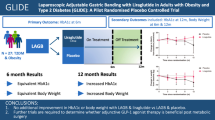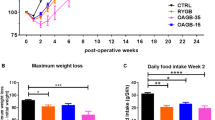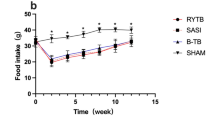Abstract
Laparoscopic adjustable gastric banding (LAGB) has rapidly emerged as a popular bariatric procedure because of its safety, efficacy, durability and adjustability. Despite widespread use, there is limited understanding of how it induces weight loss. Previously, it has been classified as a restrictive procedure, physically limiting the patient to a small meal that subsequently slowly empties into the distal stomach. However, the tiny pouch of stomach created above the LAGB appears to be unable to accommodate even the smallest of meals. Therefore, the key mechanism has been hypothesized to be the induction of satiety via, as yet, undefined pathways. The critical question remains: what are the key physiological changes that lead to satiety and weight loss? In successful LAGB patients, a consistent intraluminal pressure at the level of the LAGB of 26.9±19.8 mm Hg is observed. Studies using semi-solid swallows combined with intraluminal pressure recordings have demonstrated that semi-solid transit across the resistance of the LAGB is mediated by repeated esophageal peristaltic contractions (mean 4.5±2.9) that produce episodic flow, interspersed by reflux events. Failed transit results in obstruction and regurgitation, whereas dilatation of the supraband stomach induces severe and intolerable reflux. Overall gastric emptying does not appear to be significantly altered following LAGB. Focused investigations have shown that the supraband stomach is empty of an ingested meal 1–2 min after intake ceases. Considerable progress has been made in understanding the mechanical physiological effects of the LAGB on esophageal and proximal gastric function. These have been correlated with patient outcomes and sensations. On the basis of recent data, it appears that the LAGB activates the peripheral satiety mechanism without physically restricting the meal size. Therefore, it should not be classified as a restrictive procedure. The precise mechanism of weight loss with the LAGB remains to be delineated.
This is a preview of subscription content, access via your institution
Access options
Subscribe to this journal
Receive 12 print issues and online access
$259.00 per year
only $21.58 per issue
Buy this article
- Purchase on Springer Link
- Instant access to full article PDF
Prices may be subject to local taxes which are calculated during checkout


Similar content being viewed by others
References
Favretti F, Ashton D, Busetto L, Segato G, De Luca M . The gastric band: first-choice procedure for obesity surgery. World J Surg 2009; 10: 2039–2048.
O’Brien PE, Brown WA, Smith A, McMurrick PJ, Stephens M . Prospective study of a laparoscopically placed, adjustable gastric band in the treatment of morbid obesity. Br J Surg 1999; 86: 113–118.
O’Brien PE, Sawyer SM, Laurie C, Brown WA, Skinner S, Veit F et al. Laparoscopic adjustable gastric banding in severely obese adolescents: a randomized trial. JAMA 2010; 303: 519–526.
O’Brien PE, McPhail T, Chaston TB, Dixon JB . Systematic review of medium-term weight loss after bariatric operations. Obes Surg 2006; 16: 1032–1040.
de Jong JR, van Ramshorst B, Gooszen HG, Smout AJ, Tiel-Van Buul MM . Weight loss after laparoscopic adjustable gastric banding is not caused by altered gastric emptying. Obes Surg 2009; 19: 287–292.
Dixon AF, Dixon JB, O’Brien PE . Laparoscopic adjustable gastric banding induces prolonged satiety: a randomized blind crossover study. J Clin Endocrinol Metab 2005; 90: 813–819.
Burton PR, Brown W, Laurie C, Richards M, Afkari S, Yap K et al. The effect of laparoscopic adjustable gastric bands on esophageal motility and the gastroesophageal junction; analysis using high resolution video manometry. Obes Surg 2009; 19: 905–914.
Burton PR, Yap K, Brown WA, Laurie C, O’Donnell M, Hebbard G et al. Effects of adjustable gastric bands on gastric emptying, supra- and infraband transit and satiety: a randomized double-blind crossover trial using a new technique of band visualization. Obes Surg 2010; 20: 1690–1697.
Speakman JR . Obesity: the integrated roles of environment and genetics. J Nutr 2004; 134: 2090S–2105S.
Prentice A, Jebb S . Energy intake/physical activity interactions in the homeostasis of body weight regulation. Nut Rev 2004; 62: S98–S104.
Keesey RE . Physiological regulation of body weight and the issue of obesity. Med Clin North Am 1989; 73: 15–27.
Garrow JS . Energy balance in man—an overview. Am J Clin Nutr 1987; 45: 1114–1119.
Busetto L, Valente P, Pisent C, Segato G, de Marchi F, Favretti F et al. Eating pattern in the first year following adjustable silicone gastric banding (ASGB) for morbid obesity. Int J Obes Relat Metab Disord 1996; 20: 539–546.
Busetto L, Segato G, De Marchi F, Foletto M, De Luca M, Favretti F et al. Postoperative management of laparoscopic gastric banding. Obes Surg 2003; 13: 121–127.
Schindler K, Prager G, Ballaban T, Kretschmer S, Riener R, Buranyi B et al. Impact of laparoscopic adjustable gastric banding on plasma ghrelin, eating behaviour and body weight. Eur J Clin Invest 2004; 34: 549–554.
Horchner R, Tuinebreijer W, Kelder H . Eating patterns in morbidly obese patients before and after a gastric restrictive operation. Obes Surg 2002; 12: 108–112.
Lang T, Hauser R, Buddeberg C, Klaghofer R . Impact of gastric banding on eating behavior and weight. Obes Surg 2002; 12: 100–107.
Burton PR, Brown W, Laurie C, Lee M, Korin A, Anderson M et al. Outcomes, satiety, and adverse upper gastrointestinal symptoms following laparoscopic adjustable gastric banding. Obes Surg 2011; 21: 574–581.
Burton PR, Brown WA, Laurie CP, Richards M, Hebbard G, O’Brien PE . Effects of gastric band adjustments on intraluminal pressure. Obes Surg 2009; 19: 1508–1514.
Burton PR, Brown WA, Laurie C, Hebbard G, O’Brien PE . Mechanisms of bolus clearance in patients with laparoscopic adjustable gastric bands. Obes Surg 2010; 20: 1265–1272.
Burton PR, Brown WA, Laurie C, Hebbard G, O’Brien PE . Criteria for assessing esophageal motility in laparoscopic adjustable gastric band patients: the importance of the lower esophageal contractile segment. Obes Surg 2010; 20: 316–325.
Burton PR, Brown WA, Laurie C, Korin A, Yap K, Richards M et al. Pathophysiology of laparoscopic adjustable gastric bands: analysis and classification using high-resolution video manometry and a stress barium protocol. Obes Surg 2010; 20: 19–29.
Burton PR, Brown WA, Laurie C, Hebbard G, O’Brien PE . Predicting outcomes of intermediate term complications and revisional surgery following laparoscopic adjustable gastric banding: utility of the CORE classification and Melbourne motility criteria. Obes Surg 2010; 20: 1516–1523.
Woods SC . Gastrointestinal satiety signals I. An overview of gastrointestinal signals that influence food intake. Am J Physiol 2004; 286: G7–G13.
Crowell MD, Decker GA, Levy R, Jeffrey R, Talley NJ . Gut-brain neuropeptides in the regulation of ingestive behaviors and obesity. Am J Gastroenterol 2006; 101: 2848–2856; quiz 914.
Murphy KG, Bloom SR . Gut hormones and the regulation of energy homeostasis. Nature 2006; 444: 854–859.
Murphy KG, Dhillo WS, Bloom SR . Gut peptides in the regulation of food intake and energy homeostasis. Endocr Rev 2006; 27: 719–727.
de Fatima Haueisen Sander Diniz M, de Azeredo Passos VM, Diniz MT . Gut-brain communication: how does it stand after bariatric surgery? Curr Opin Clin Nutr Metab Care 2006; 9: 629–636.
Wang Y, Liu J . Plasma ghrelin modulation in gastric band operation and sleeve gastrectomy. Obes Surg 2009; 19: 357–362.
Geary N . Endocrine controls of eating: CCK, leptin, and ghrelin. Physiol Behav 2004; 81: 719–733.
Author information
Authors and Affiliations
Corresponding author
Ethics declarations
Competing interests
WA Brown received consulting fees from Allergan and an unrestricted research grant for her team from Allergan. WA Brown has also served as an expert witness for medical legal cases in relation to obesity surgery. PR Burton declares no conflict of interest.
Rights and permissions
About this article
Cite this article
Burton, P., Brown, W. The mechanism of weight loss with laparoscopic adjustable gastric banding: induction of satiety not restriction. Int J Obes 35 (Suppl 3), S26–S30 (2011). https://doi.org/10.1038/ijo.2011.144
Published:
Issue Date:
DOI: https://doi.org/10.1038/ijo.2011.144
Keywords
This article is cited by
-
Bariatric Surgery in NAFLD
Digestive Diseases and Sciences (2022)
-
Comparison of the mid-term outcomes of banded and non-banded sleeve gastrectomy: safety, food tolerance, and weight regain
Surgical Endoscopy (2022)
-
Preoperative Binge Eating and Weight Loss After Bariatric Surgery: A Systematic Review and Meta-analysis
Obesity Surgery (2021)
-
Pre-operative Restraint and Post-operative Hunger, Disinhibition and Emotional Eating Predict Weight Loss at 2 Years Post-laparoscopic Adjustable Gastric Banding
Obesity Surgery (2020)
-
Primary Banded Sleeve Gastrectomy: a Systematic Review
Obesity Surgery (2019)



